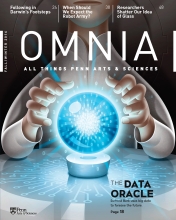From the internment of Japanese Americans during World War II to the wars in Korea and Vietnam, the status of Asian Americans has been conditioned by U.S. foreign relations. Josephine Park, an associate professor of English, started out to write a book on the portrayal of “the Asian enemy.” But she was surprised by what Asian Americans themselves were writing in the second part of the 20th century.
“The Asian American literature I was reading wasn’t about the demonization of Asians,” she says. “Instead they were saying, ‘Oh, we love America. You know we’re your best friends, right?’ They’ve been in the war, they’ve been tortured. And yet they still wanted to be America’s best friend.”
Whether these sentiments were real or a survival tactic, Park became interested in how the writers were incorporating themselves into U.S. society. Instead of a book about enemies, she wrote Cold War Friendships: Korea, Vietnam, and Asian American Literature.
Most Koreans and Vietnamese who came to America after the war had been allies—known as “friendlies”—of the U.S. in Asia. The term had first been used in New Zealand to describe natives who were working with the empire. “So they are racially marked, and they are compromised from the start,” Park says. “When you’re a friendly, you can’t be a real friend.”
The first Asian American literature after Korea, says Park, tended to be about the experience of the writers, or of people the writers knew. But much of this literature was heavily fictionalized and based on Western models. One of the most successful authors, Richard E. Kim, was a South Korean army officer who got a scholarship to go to Middlebury College, then earned an M.F.A. and eventually taught at the University of Iowa. His book The Martyred opened with an epigram from Camus and made the New York Times bestseller list. “This was someone who was carefully schooled in the new postwar professionalized writing class,” says Park. “He was telling a version of his own experiences on the battlefield. But he’s translating them into a high literary form. It’s not a book about the politics of the war at all; he wants it to be a philosophical meditation.”
While Koreans migrated to America in waves, Vietnamese refugees came in a flood right after the war. Most early Vietnamese American writers focused on the refugee experience. The best-known is Le Ly Hayslip, whose book When Heaven and Earth Changed Places: A Vietnamese Woman's Journey from War to Peace was made into a film by Oliver Stone.
A woman from the peasant class with a grade school education, Hayslip told her story in English and addressed it to the American G.I.s. “There is Vietnamese American literature which is more interesting and aesthetically sophisticated,” Park says. “But I went back to her because I thought she was actually doing something really powerful. She’s taking this kind of Buddhist conception and says, ‘I forgive you, American G.I.s.’ And she also says ‘My story is what I want to tell you because I was at the middle of the war.’ She takes the reins of her own story.”
In both Korea and Vietnam, friendlies justified the fight and were pulled into proxy warfare. Despite the inequality of the relationship, though, Asian American writers drew on it and their experiences to stake their own claim on America.
“I don’t need to police them on their politics,” says Park. “The protagonists who had been damaged through the encounter with America on the battlefield wanted to use that to their advantage, to make a claim to belong.”




